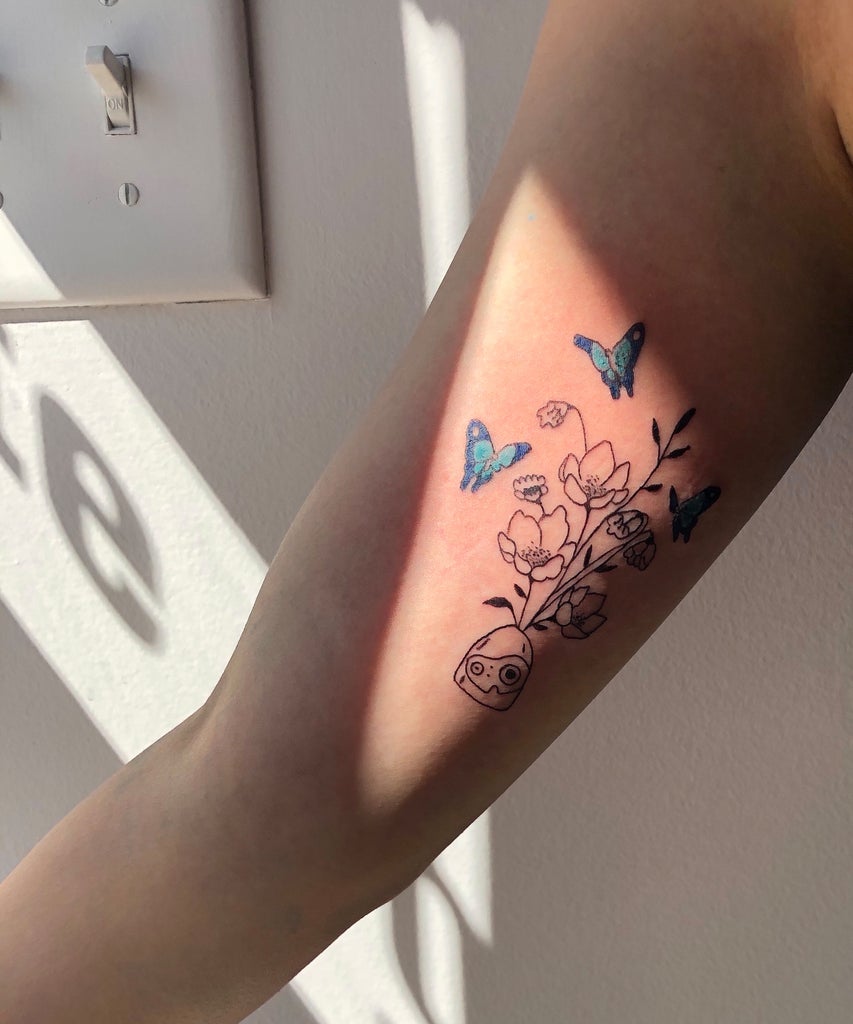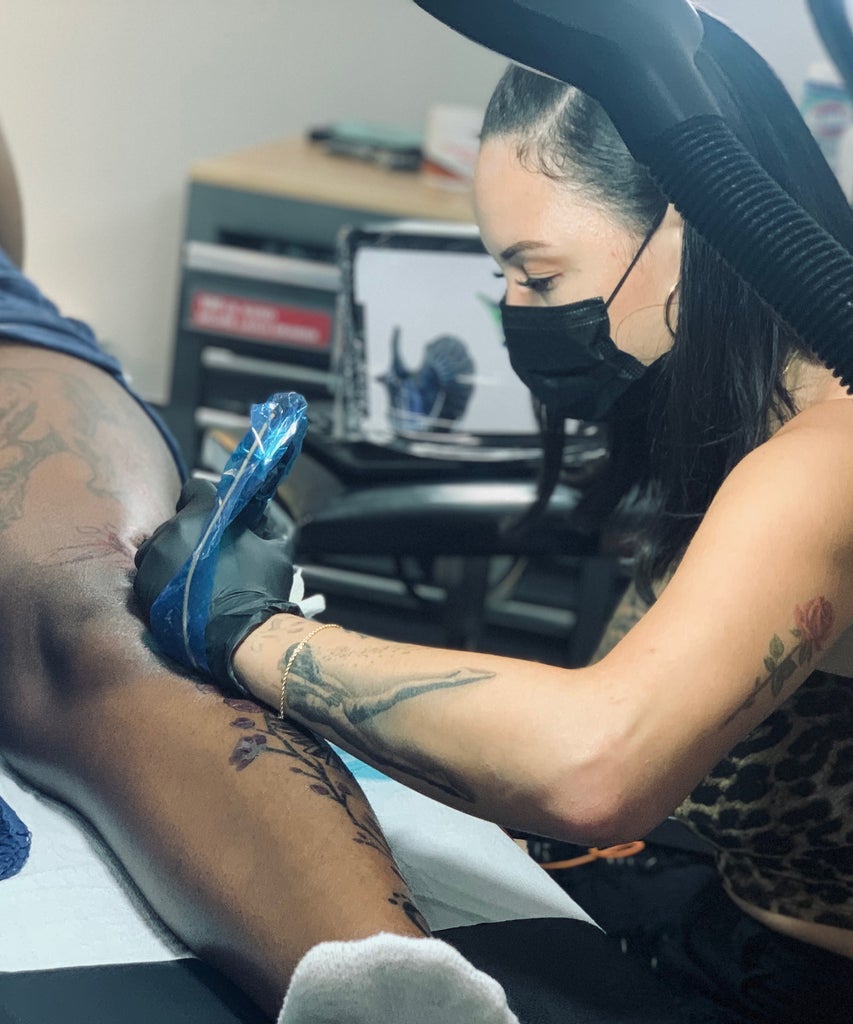In the very first week of quarantine, Tammy Hong realised she had been here before. Not stuck at home, caught in the slogging dread of a global pandemic, exactly, but feeling anxious, unsettled, and depressed. “I have extreme adjustment anxiety. Working from home was not working out for me in the very beginning,” she says. “I lost relationships because of my mental health state and developed a bunch of health problems because my body was reacting to how stressed I was.”
As someone who had experienced similar episodes of depression in the past, Hong knew what to do: seek medical treatment and doodle tattoo designs. “As an artist, my stress release and way to deal with my depression is really to make art,” she says. “I always try to see my depression and anxiety as a way of my creativity tugging at me to get attention.” Within an hour, Hong had sketched a design inspired by one of her favourite childhood films, Castle in the Sky. After months of fine-tuning the artwork at home, researching area tattooers, and waiting for mandates to lift, she made it official on July 10 with a generously-sized tattoo on her inner bicep.

As the world continues to push through the pain, loss, and challenges of COVID-19 and widespread social unrest, Hong is just one of many who are turning to tattoos. Though it’s early for market research to show a data-driven surge in mid-pandemic tattooing, anecdotal evidence is emerging: Katrina Jackson, owner of Enigma Tattoo in Beverly Hills, reports that both inquiries and bookings at her Beverly Hills shop have doubled since April versus last year, despite unusually long wait lists prompted by mandated closures. Elva Stefanie, a tattoo artist and owner of The Blank Slate tattoo shop in New York’s Hudson Valley, said requests for bookings also doubled in May and quadrupled at her monthly residency in a Maryland shop. Even temporary tattoo shop closures didn’t slow interest. Orders for DIY tattooing gear from Bay Area company Stick and Poke Tattoo Kit have increased by 150% on average since stay-at-home mandates began in March, and search for “tattoos” is up 48% according to Google Trends.
This nagging itch to get inked isn’t something that surprises Dr. Vinita Mehta, a DC-based psychologist who specialises in treating depression, anxiety, and life transitions. “If the research is really tracking this correctly, I think we would expect some kind of spike in tattooing just because so many people are going through something stressful right now,” she says.

Stefanie, who has nine years of experience in the field and multiple degrees in art history, was prepared for the onslaught. The tattoo artist says that if history has shown us anything, it’s human nature to make art from chaos. “In primitive times, cavemen would paint images of seeds when they didn’t have food, or extremely fertile-looking women if women were having trouble with labor,” she says. “Art is the way people express themselves through different periods of need. With so much going on right now, I’m not surprised that more people are expressing themselves with body art and tattoos.”
Still, there are plenty of people who will shoulder the stress of job loss, social unrest, and COVID-19 without even thinking of getting inked in response. That’s because it’s not the events themselves that are sending us to the nearest open tattoo shop, as Dr. Ali notes, but our experiences within the pandemic that solidify our values and sense of fortitude. “I’ve had a lot of people talk about having their lightbulb moment in the pandemic and realising a lot about themselves, their loved ones, or their careers. That specific moment happens because of the influence of the pandemic,” Dr. Ali says. “If anything, the pandemic can be more of a catalyst. Since tattoos are oftentimes linked to self-expression and deeper meaning, [they] can be more about a person’s resilience in that process or something they endured.”
When you think about the function of art in society, what does it really do? It can be pretty, challenge us to think about things in a new way, or be a form of resistance.
Dr. Vinita MehTa
Indeed, the doodle that became Hong’s latest tattoo isn’t just a pretty depiction of plant life and butterflies inspired by the Hayao Miyazaki film. She sees it as a badge of strength and triumph. “I think of my tattoo as a symbol of success or transformation,” Hong says. “For me, dealing with depression is a journey with so many high and low points. This tattoo is a reminder of having overcome a depressive episode and that I can do it again in my journey.”
Hong’s instinct to get inked as a way of marking her growth is something Dr. Shainna Ali, an Orlando-based mental health counsellor and author of The Self-Love Workbook, says can positively affect a person’s mental health. “We do things to remind ourselves of our strengths and resilience, and getting a tattoo is just another form of that,” she notes, citing the popularity of the semicolon tattoo among suicide and self-harm survivors as a symbol of choosing to continue life.

As vastly different as each of our pandemic circumstances continue to be, so are people’s motivations to honour the life event with fresh ink; creating an indelible reminder of triumph over trauma is just one way to do it. “People may want to look back at this moment and think about how they have changed and grown as people and it’s absolutely possible that tattooing could be one of the ways that they choose to express this,” Dr. Ali notes.
Jessica McGrady, a creative agency account manager in London, has long turned to tattoos to punctuate major life events. “I get tattooed at times where something has happened that I want to remember, like when my sister was born,” she says. After an introspective three months in quarantine, during which tattoo shops in her area had been shuttered, McGrady ordered DIY tattoo gear from Stick and Poke Tattoo Kits to try her own hand at expressing herself through the art form. “I suppose it may sound a bit strange: Why would you want to remember a global pandemic? But I think it was about a little bit more than that. Taking a break turned into quite a journey of understanding myself. It’s been a transformative time.”

McGrady, who has tiny tattoos on her fingers in addition to 11 other pieces on her body, inked the word “self” on her right wrist, along with a viking pagan symbol on her middle finger to represent new beginnings. “I wanted something to remind me of this time,” she says. “In quarantine, I’ve learned that a lot of what I used to get stressed about doesn’t really matter or make me who I am. That’s why I chose to put ‘self’ right on my hand where I can see it, to bring me back down to earth if I ever lose sight of what really matters again.”
McGrady’s decision to ink herself when tattoo shops were closed is indicative of how some use body art as a way to process monumental experiences. “Many times, you’ll find that tattoos resemble a very significant chapter or event in a person’s life that she or he wanted to mark in a way that self expresses,” Dr. Mehta says. “From a therapeutic, psychotherapy perspective, you can see tattooing as a form of processing an event of personal significance.”
This may help explain why Jackson has seen an uptick in more meaningful and personal tattoo requests versus trend-driven designs, like tiny waves or palm trees. “I can honestly say I haven’t seen too many inquiries for little trendy tattoos. People are coming with more thought-out and personal artwork they want done,” she says. ”It could be that time in isolation has given people the time to sit down and think about something with a deeper meaning for them.”

The compounding traumas of 2020, which include a spotlight on widespread racial injustice, are further fuelling the need to process emotions through art. Along with portraits and tribute tattoos, Jackson and her team of seven artists have created more pieces inspired by Black history and movements like Black Lives Matter than ever before. Similarly, Stefanie (who is known, in part, for her letterwork), has fielded more requests for both affirmation-driven tattoos (“breathe”) and social justice-inspired phrasing (“I can’t breathe”) during the past few months. “I think collectively people are getting tattoos during this time because things like the George Floyd tragedy probably affect them just as much as going through something deeply personal,” Jackson says.
Whether it’s circumstances of a global pandemic, months spent in self-isolation, or a social justice movement that trigger deeper self awareness, getting a tattoo in response can help us express ourselves externally and better comprehend what we’re experiencing internally. “When you think about the function of art in society, what does it really do? It can be pretty, challenge us to think about things in a new way, or be a form of resistance. So the term ‘body art’ is apt for the person who is getting the tattoo,” Dr. Mehta says. Like other creative outlets, tattooing may help some people process and integrate an important experience, Dr. Mehta notes, adding, “When something is expressed, it becomes more consolidated in one’s mind.”
As much as Hong’s quarantine tattoo serves as an affirmation for her personal life, it also bears social significance that brings deeper meaning to her work as an art historian. “There’s a scene in Castle in the Sky in which the robot is taking care of all these plants and animals while waiting for his princess to come home. When designing my tattoo, I was thinking of that as it relates to the George Floyd incident,” Hong says, explaining that the design she created isn’t only about celebrating her own self care, but serves as a pledge to nurture others. “It reminded me of the larger purpose of why I do art and art research. It’s really about social justice, reaching this cultural empathy, and using art as a platform for encouraging dialogue with different groups.”
Like what you see? How about some more R29 goodness, right here?
I Got A Tattoo To Give Old Scars A New Meaning